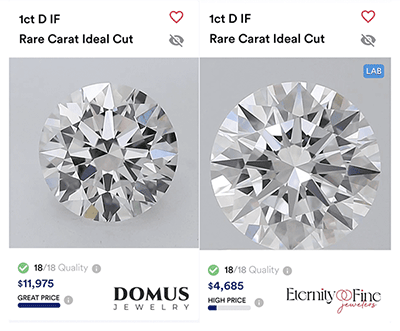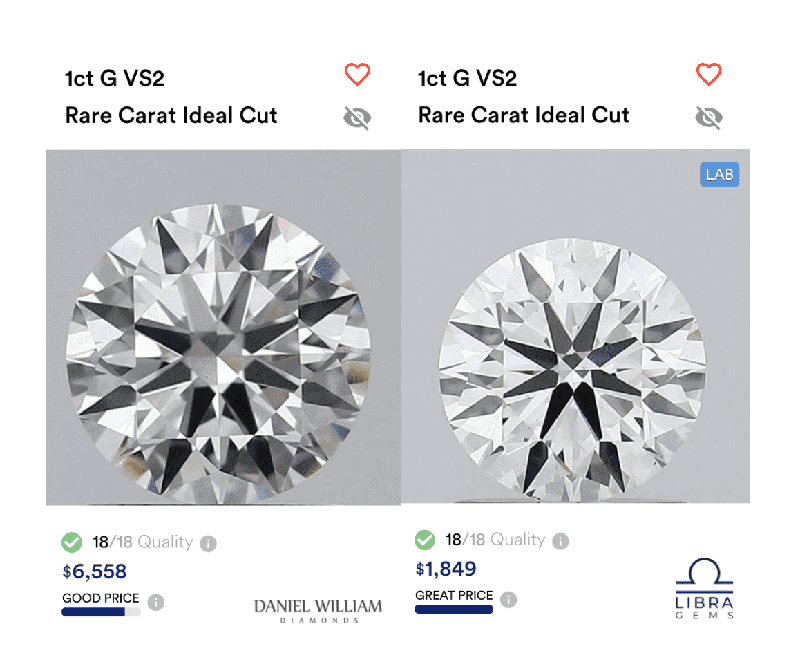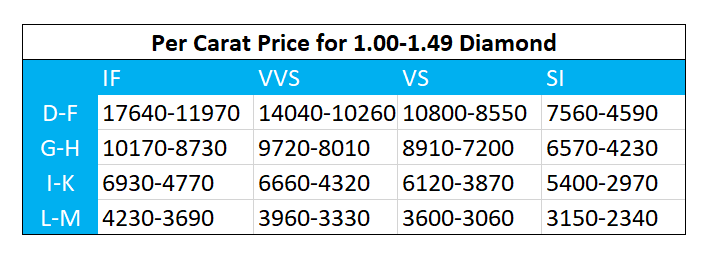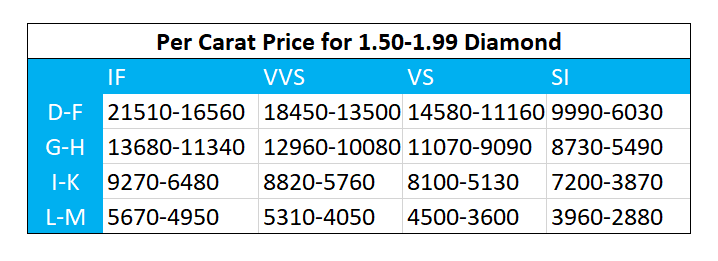Ah yes! The diamond questions of all diamond questions. The question about price and about the mythical 1ct. While the question sounds like it may have a straightforward answer, this is a question that touches on almost all aspects of diamond pricing. It is kinda like the mythical hydra with one head turning into many heads. But don't worry my dear reader, I have got you covered on this one.
Before we begin tackling this hydra of a question, let's talk about the different nuances that need to be addressed. No diamond is solely priced on its appearance alone. For example, a 1ct D color Flawless might look almost identical to an F SI1 next to each other, the price might be $10,000 apart. So what are some factors that influence the worth of a 1ct diamond?
Origin, Weight Category, Shape, 4Cs lastly, Price vs. Worth
Magic Unit: Price Per Carat
Just as any great movie begins with an excellent trailer before the movie is even released, I will have to introduce you to a magic unit in the diamond industry before we talk about pricing. That magic unit is the price per carat.
All you need to do is divide the total price of the diamond by the carat weight of the diamond. Voila, now you have the single most powerful tool to talk about the price of any diamond on the market.
Why is it such a powerful unit? Because it can tell you how much the diamond is worth or how much someone is asking while disregarding everything else like color, clarity, fluorescence, and so on. Now you can compare any two diamonds regardless of their other qualities as long as you have the price and the carat weight.
So let's get to dividing and conquering the diamond price code.
Origin: Natural vs. Lab-Grown
The first and foremost would be the origin of the diamond, specifically referring to the difference between lab-grown vs. earth mined diamonds. There is no surprise here. Earth-mined diamonds will always be more expensive than laboratory-created diamonds...and by a lot.
A D color, internally flawless natural diamond is priced around $18,000 while a lab-created one goes for $8000 which means that a natural diamond is close to 2.5 times the price of a laboratory-grown diamond.
 These differences get even crazier when you get to the more common color and clarity. Because the laboratory creation process produces more diamonds around the middle carat range and middle clarity ranges, let's compare two G VS2 stones. A natural diamond is priced around $6500 while a lab-created one goes for $1500. In this case, the natural diamond is more than 4 times the price of a laboratory-grown diamond.
These differences get even crazier when you get to the more common color and clarity. Because the laboratory creation process produces more diamonds around the middle carat range and middle clarity ranges, let's compare two G VS2 stones. A natural diamond is priced around $6500 while a lab-created one goes for $1500. In this case, the natural diamond is more than 4 times the price of a laboratory-grown diamond.
 In short, a natural diamond will be worth on average 3 times more than a laboratory-created diamond.
In short, a natural diamond will be worth on average 3 times more than a laboratory-created diamond.
Carat Range: 1.00-1.49 / 1.50-1.99
While it sounds absurd that a 0.01ct weight difference could impact the price significantly, this 0.01ct would mean a 25% increase in the per-carat price. How come?
Diamond traders, although mysterious, are still humans. And we humans can't live without mental shortcuts. We intuitively know that a 10ct diamond is definitely rarer than a 1ct diamond and worth more. On the other hand, people cannot create a distinct per-carat price for every single weight on the scale. That would create millions of distinct price points when you take color, clarity, and cut into consideration.
People compromised around these two facts of life and created weight brackets under which the per carat prices are grouped. For 1 carat stones, diamonds under 1.49ct and diamonds above 1.50ct actually fall under two distinct price brackets.
Know that if your diamond is above the 1.50ct threshold, the per-carat price is going to be at least 20% higher than a 1ct stone under the 1.50 cut-off with the same color, clarity, and cut.
Shape: Round vs. Fancy
After that, we have the issue of cuts. You would think a shape is just a shape right. Well, some shapes actually yield much smaller final products and some shapes are vastly more popular than others. This is all seen reflected in the final price. For fancy cuts, a diamond commonly retains more of the rough weight than the notorious round brilliant cut. The natural diamond rough tends to form in predictable shapes and some shapes capture more of the rough than others. For fancy cuts, the rough sheds around 40-50% of the weight as it goes through the process of faceting. For round brilliants, the diamond rough can shed up to 50-60% of the original weight requiring a much larger rough to get the same final product. This all translates to an average of 20% price premium when you compare rounds vs. fancy cuts. So if your 1ct diamond is a round that means it is worth a solid 20% or more than its fancy shape counterpart.
The details - the 4Cs:
Now that we have all of that out of the way, we can finally get to the nitty-gritty of diamond pricing. It would be kinda insane to give you all the pricing information in paragraph form, so I am going to take a page of the playbook from the industry professionals and give you the details in table form. Since diamond prices are due to market supply and demands and highly based on the vendor that you are buying it from, I have consolidated two charts below for diamonds in the 1.00 to 1.49 range and 1.50 to 1.99 range. Know that they represent high estimates and always rely on the Deal Score indicator next to all the diamonds on Rare Carat for more reliability and precise comparison.


Price vs. Worth:
Finally, let's discuss the elephant in the room all along. Price vs. Worth.
It's all fine and good when we talk about prices, but what are they worth in the end after the purchase. Is it like a car that rapidly loses value the longer you own it or is it more like a house that might actually appreciate with time?
Diamonds are actually kinda in between these two leaning a bit closer to the house example. A diamond is able to retain its value really well over long periods. Over the last 15 years, the average price of a 1ct diamond has increased by 10% of its per carat value and over the last 20 years 15.75% on average.
But what about turning that old 1ct back into money and hopefully some profits? That is what is really meant by worth, isn't it? Well, if you asked me 5 years ago, I might have given you the bad news. Back then, only a few places would take your diamond and some might even take a huge chunk out of your stone. Pawnshops and jewelry stores would only pay a fraction of what you paid for it. However, many platforms on the internet have sprung up to meet the demand of trading in second-hand diamonds. You now have plenty of trustworthy, fast, and convenient options to turn your precious 1ct diamond back into cash. Much like how a real estate agent might take a cut of the sale, you might end up less than what your final price tag says, but you can now pick and choose.
So, your diamonds might lose some value when you decide to resell them, but overall a diamond retains its worth or value relatively well over long periods of time.

